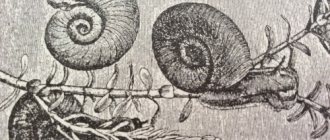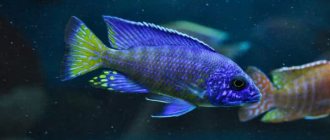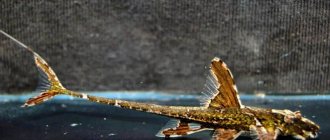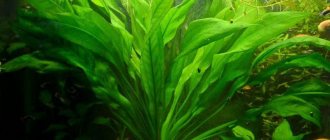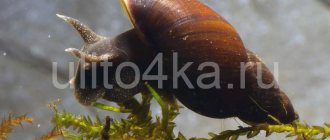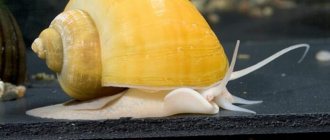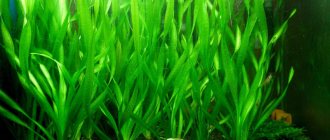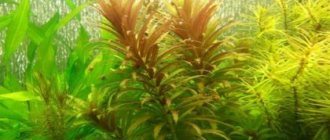Aquarium snails Neritina Zebra (Neritina)
Size up to: 3 cm. Is it necessary in an aquarium?
Yes. Do plants spoil? No. Neritin Zebra snails are one of the most beautiful and useful freshwater aquarium snails. They eat algae, which are absolutely harmless to plants. Freshwater, but representatives of the family, most of the species of which are marine Molluscs. They live for about 3-4 years. Otherwise called: Zebra, Tiger, Neritina Natalensis sp. Zebra, Nerites Zebra.
Description . The sinks are with black and gold stripes. The pattern of stripes is unique and inimitable for each individual. Nutrition . Neritin's main food is algal fouling. They move slowly and if the walls are dirty, you can see a clean trail behind the Tiger Snails. They clean glass so well that no Ampularia or Ancistrus catfish can compare with them. If there are few algae on the glasses, they are fed with special food or algae wafers. N. Zebras are much larger in size than other Neritines, so they will not be able to clean small leaves and twigs.
Neritina
Compatibility . The other inhabitants are not bothered, they are simply not interested. Conditions of detention . They can run away from the aquarium, especially if they don’t like something about the water parameters or other living conditions. They are amphibians, so they can safely stay out of water for some time. Carefully monitor their attempts to escape; if exposed to air for a long time, they will not last long. The water must be hard. If it is soft, the appearance of the shell may deteriorate and it will gradually collapse. Temperature 22-26°C, hardness 8-12°, water acidity 7.2-8.5 pH. Breeding . Dioecious. They cannot reproduce in fresh water; for this they definitely need sea water. The floating larva emerging from the eggs requires salted water and the presence of plankton in it. It was possible to obtain offspring in fresh water, but they died after a short period of time. Eggs are usually laid on plants and soil, as well as glass and interiors. And this fact is, perhaps, only one disadvantage. They look like tiny white dots and, being on glass and decorations, slightly spoil the internal aesthetics.
N. Red dotted
Neritina Juttingae
N. Spotted (Neritina Juttingae) - size up to 2 cm, very good at cleaning glass from algae and at the same time not touching the plants at all, active at night. Otherwise: Neritina Red Dot, Vittina Semiconika, Orange Saucer, Nerita Diamant. Description . The color of the shells varies from orange to pale brown. There are dots or stripes on the shells. The pattern of the stripes depends on the area where they live. Sex differences . External sexual characteristics are practically indistinguishable. The female can only be identified during the laying of her cocoons. Nutrition. A variety of plant foods are recommended: lettuce leaves pre-scalded with boiling water, green cucumbers and zucchini cut into slices, as well as spirulina tablets. They eat spoiled plant leaves and the remains of dead fish well. Compatibility . N. Spotted can be kept with almost all types of underwater inhabitants, with the exception of those that feed on shellfish, for example, Cichlids. Content . Sometimes they can crawl out, so a lid is needed. If you do not notice the fugitive in time, she may die. Water . 20-27°C, dH 8-12°, acidity pH 6.5-8.5. The water should not be too soft so that their shell does not begin to collapse. They have gill breathing, so the water must be clean and a filter is required. It is advisable to replace 1/3 of it with fresh weekly. Reproduction . Brackish water is required to produce viable offspring. In fresh water, a few days after birth, all larvae die. The female lays her eggs in the form of white cocoons throughout the tank. The caviar holds very tightly and it is quite difficult to remove it from the surface to which it is attached. Each such cocoon contains about 50 eggs. The clutch of eggs must be protected from Cichlids, who are not averse to eating it.
Theodoxus
Freshwater Neritida (Theodoxus Fluviatilis)
Freshwater neritids (Theodoxus Fluviatilis) - size up to 1 cm, domestic representatives of Neritin, absolutely problem-free and non-harmful, algae eaters. Otherwise called: Theodoxus, Ladybug, Hole, River Hole, River Neritida. Theodoxis are heterosexual and actively produce offspring when there is a sufficient food supply. Spreading . Ukraine and Russia, many rivers in the basins of the Black, Azov and Baltic seas, in the rivers Dnieper, Desna, Dniester, Southern Bug, Don and many others, as well as in reservoirs adjacent to these rivers, large clean lakes, in the estuaries of the northwestern Black Sea region , in the Odessa and Finnish gulfs.
Ampularia (Pomacea)
Table of basic parameters of maintenance, care and nutrition:
| What should be the volume of the aquarium? | for most types from 10 liters for some types from 90 liters |
| What should the temperature be? | from +18-30° C depends on the type |
| What pH should it be | from 6.5-8 pH |
| What should be the stiffness? | from 8-18° dH |
| What should the substrate be? | coarse or fine sand, fine grains of substrate (soil) 1-2 mm in size |
| What kind of lighting should there be? | moderate |
| What should be the movement of water | moderate |
| Maximum size | from 1.5-9 cm, depends on the type |
| What does it eat? | aquarium algae: healthy or rotting; fish food; raw or boiled vegetables |
| Type of aquarium snail | depends on the type: peaceful; predators |
| Who is compatible with in an aquarium? | compatible with all peaceful aquarium inhabitants |
| Lifespan | from 1-5 years depending on the type and conditions of detention |
Ampularia (Pomacea)
Size up to: 10 cm. Is it needed in an aquarium? Yes. Do plants eat? Yes. But personally, I didn’t notice any damage to plants from them.
Ampullaria (Pomacea, or Ampullaria) are large freshwater snails. They breathe both atmospheric oxygen and oxygen dissolved in water. They have both gills and lungs, so they can live out of water for a long time. Description . The eyes are yellow-golden in color, located on stalks at their base. There is a very long breathing tube. There are 2 very long eye antennae (tentacles), which are organs of touch. They have a keen sense of smell, which helps them accurately find the location of food. There is a small horny cap located on the back of the leg. This is a kind of “door”, with the help of which they close the mouth of their shells when they hide in them. What Ampularia use to chew on leaves is not, in the strict sense of the word, jaws. This special device is a radula (grater), designed mainly for scraping food. Only large individuals whose lateral radula appendages are quite powerful can bite off a leaf.
Nutrition . Adults are omnivores. You can feed with bread crumbs, scalded slices of fresh cucumber, lettuce, scraped meat and even scalded semolina. It is best to take advantage of their omnivorous nature and place them in a tank overgrown with algae with leftover fish food. They clean large volumes well. The water in those containers where Ampularia live is much cleaner than in those where they are not. They must have enough food, otherwise they will take on aquatic plants, especially those that float on the surface of the water (Riccia, Duckweed, etc.). If you plant a plant such as Elodea canadiana, which is inedible for them, then you can achieve excellent cooperation and obtain biological balance in an artificial reservoir. Compatibility . It is better to keep it with small viviparous fish or catfish. Predators, such as Cichlids and large Labyrinths, can harm them or destroy them completely. Recommended conditions of detention . 10 liters of water per 1 Ampoule, soft soil, hard plant leaves. A lid is required, because They love to crawl along the walls of their home; they can crawl out and die after some time without water. Water . The hardness of the water is not important, but in a soft shell it will gradually begin to collapse. Frequent water changes are recommended. They like to be warm, the suitable temperature for them is 22-30°C.
Reproduction . Dioecious, requires the presence of a male and a female. The female lays her first clutch at the age of 1 year or a little older. Eggs are laid not in water, but on land, in the dark. The eggs are large, up to 2 mm in diameter. After fertilization, the female sticks them to the glass in a place located above the water level. At first the masonry has a softer consistency, after about a day it becomes hard and light pink in color. As small snails form, it darkens and by the end of maturation it becomes almost black. After a short break (several days, months), the female repeats the clutch, but with fewer eggs. This can continue all year round if conditions are favorable for them. The babies are hatched within 12-24 days. The higher the temperature, the sooner. For a successful hatch, normal air humidity is necessary. If the eggs are exposed to excessive heat, for example from a light lamp, they dry out and the embryos die. But they shouldn’t be in water either, as it can kill developing snails by washing away the top layer of eggs. If all conditions are met, they emerge without outside help, making an exit for themselves in the shell and falling into the water. Small ones are grown separately from adults (not necessarily), in small volumes of water. You can give cyclops, finely chopped plants like Riccia and Duckweed. Sensitive to the purity of water, it is necessary to monitor its quality and partially change or filter it. They grow quickly.
Species, how to identify Ampularia by shell shape?
Only P. bridgesi is suitable for the herbalist, since their soft radulas are not capable of damaging plants, they can only feed on dead and rotten parts of them. Ignore the color of the shells when trying to identify them from photographs. There are many variations of all possible body and shell colors within the same species. Sometimes others are also sold, not described here, mainly with receipts of imported goods. In this case, identification can be quite difficult. Pomacea Bridgesi - flat slopes of adjacent turns, 90° angle between the mouth and the first turn, the plane disappears towards the last turns of the shell. Size: 4.5-6.5 cm. Pomacea Canaliculata - aperture creeping onto the first turn, angle less than 90°, shell more rounded than that of Pomacea Bridgesi. Size: 4.5-8.0 cm. Pomacea Paludosa - very gentle slopes of turns, the angle to the mouth is more than 90°, the apex of the shell is close to a cone in shape. Size: 4.5-6.5 cm.
U. "Apple"
Caviar U. "Apple"
Diseases
Most often, diseases arise due to improper maintenance. If you do not feed the snail with calcium, the shell will begin to deteriorate. And you can also add eggshells, shells or chalk (all crushed) to the water. The cuttlefish skeleton (there are a lot of proteins there) can be lowered into the aquarium, the snails will gradually scrape it off.
If there are indentations on the sink, these are most likely mites. You should carefully remove the pet from the water, blot the shell with a soft cloth, then wipe it with a cotton swab soaked in formaldehyde. Protect the animal from getting this liquid on its body.
A white coating on the shell indicates the presence of other parasites. Then you need to place the snail in a salt solution (10 g per 1 liter of water), hold for 15 minutes.
Due to lack of oxygen, the animal may fall into a coma and because of this, the snail may not crawl out of its shell. The clam should be transplanted into a jar of clean water.
Sometimes diseases include green plaque on the sink. But this is not so, you just need to clean the shell with a soft toothbrush (without soap or other products).
Conclusion
Some species help keep the aquarium clean by reaching where human hands and tweezers cannot reach. These mollusks are part of different environments and provide food for many organisms, so they should be considered a necessary and important part of any aquatic ecosystem.
U. "Apple" (Asolene Spixi)
Size up to: 3.5 cm.
U. “Apple” is also called: Apple, Zebra, Zebra Apple Snail, Spixi Apple Snail. New and less common. Origin: Southeast Brazil. Heterogeneous. They lay eggs underwater. Asolene Spixi often eat their eggs. There are about 30 eggs in the clutch. About 50% hatch. Most newborns die for unknown reasons. Omnivores.
Aquariums with and without fish
In aquariums with various inhabitants, snails help clean the environment from waste products, and also eat up the remains of uneaten food and feel quite happy. Therefore, most aquarists do not have a question about what to feed snails in an aquarium with fish and other living creatures.
The question most often arises is what to feed snails in an aquarium without fish. In this case, you will have to feed the gastropods additionally. These animals can eat:
- aquatic plants,
- algae,
- fruits,
- vegetables and fish food.
Pond snail (Lymnaeidae)
Size up to: 5 cm. Is it needed in an aquarium? No, they have no benefit, but they can damage plants.
Our domestic pond fish (there are many types) can be seen floating on the surface of the water of lakes and ponds. Under no circumstances should you specially bring them into a tank with fish and plants. They will immediately eat plants, and they can infect fish with Trematode larvae. Description . The shell has a round, cone-shaped shape, strongly pointed towards the top, curled to the right. There are eyes on the outside of the flat triangular tentacles. The leg is short and wide. The body is gray-green, the shell is light yellow. They breathe with their lungs and therefore from time to time rise to the surface of the water for air.
U. Pokemon, Radix, P. Tropical
Water . Low temperature is more suitable. Nutrition . Pond fish eat a lot and are omnivores. Breeding . The caviar is attached to the underside of the leaf and is a gelatinous mass in the form of an icicle. Each icicle contains up to 100 transparent eggs. The baby hatches within a month.
Tropical pond snail (Radix rubiginosa)
Tropical pondweed (Radix Rubiginosa) is a tropical analogue of our domestic pondweed, size up to 1.5 cm. Otherwise called: Pokemon, Radix. Origin: Malaysia and Indonesia (Borneo). There are several varieties of P. Tropical with different body and body colors. Light and transparent body shapes are the most decorative. Pokemon are quite omnivorous, prefer fouling, do not disdain even blue-green algae, love rotten leaves, and live plants are the last thing they touch. Radixa are hermaphrodites and produce offspring without any problems.
Maintenance and care at home
Snails are recognizable mainly because of their slowness. They are considered plant pests in the garden. Invasive snails also appear in aquariums and are a big problem (they need to be controlled in various ways). However, most species (from tropical areas) play an important role as "scavengers". Some of them are predators and dangerous to fry or other small creatures (such as shrimp).
Almost all snails have very poor tolerance to water that is too soft and acidic (then they lack the minerals needed to build shells).
In order for a mollusk to build a strong shell, the water in the aquarium must be hard and saturated with calcium.
But snails are also hardy, adapting to any conditions, including temperatures from +18-28°C. It is better not to take them from reservoirs into your aquarium, but to buy them at a pet store. They live better in warm water and reproduce more actively. But too much birth rate is also bad.
An important point for aquarium snails is the soil. Streets prefer coarse or fine sand, but soil 1-2 mm in size is also suitable.
Some species are escapees. For example, for large apple snails, the aquarium should be tightly closed, and 2 cm of space should be left between the surface of the water and the lid for free breathing and for laying eggs.
Representatives of the genus Tylomelania are more demanding (they need crystal clear, oxygenated water with a fairly high temperature). Caring for them can be recommended to more experienced aquarium lovers.
For comfortable living, the volume of the aquarium is the same as for aquarium fish: 1 aquarium snail needs 10 liters.
Horny Coils (Planorbarius Corneus)
Size up to: 3 cm. Is it necessary for a home pond? No. If there are already Coils, then you need to catch them regularly, luring them to a piece of food or collecting them with a small net. Do plants spoil? Yes, they eat higher plants, especially those with delicate foliage.
Description . The shell is twisted in a spiral in one plane. They have a rather hard radula, which can injure the tissues of plant leaves. They move using their legs. They orient themselves through a pair of tentacles located on the head and eyes, which are located at the base of the tentacles. They can also move along the surface of a reservoir, attaching to the surface tension film of water. They can breathe both atmospheric air and oxygen obtained from water. Breathing with atmospheric air is resorted to when there is little oxygen in the water. They do not have real gills, but they have a thin projection formed by the walls of the mantle. This pulmonary cavity in its functionality replaces the gill.
U. Black, Pond Reels
How do they get into the home pond? Typically, Red Horned Coils are brought into a home pond with newly purchased plants that may contain their eggs. Extremely tenacious, they can live even in very dirty water. Under conditions of chronic starvation, they do not disappear, they only become very small. Disease carriers . There are Black Pond Reels. It is not worth taking them from nature and planting them in a tank with fish. In nature, any U. Coils are carriers of dangerous helminthic diseases of fish and warm-blooded animals - Trematodes. They cannot directly infect a person. Trematode larvae leave the body of the Mollusk and penetrate the fish. Can I feed fish with them? Many fish love their meat. Cockerels and Macropods can purposefully hunt for U. Coils. They wait for a long time until they stick out of the shell, and then they grab onto them and drag them away. Other fish willingly eat crushed ones. You can even prepare a delicious fortified dish from them. Thoroughly grind the kernel from the multivitamin pills and about two dozen Coils in a mortar in a mortar. The resulting jelly retains water-soluble vitamins well and fish eat it greedily. Relative utility . They destroy algae and bacteria deposits on glass and leaves. But they don’t clean anything completely, but rather eat away the winding paths that are clearly visible on the glass. They are useful by eating bacterial films on the surface, but they are formed only in those containers where there is no filtration and aeration (are there such things now?). They are of little use to aquarists, but as an interesting and unpretentious object for children's observations, they are quite suitable. Reproduction . Hermaphrodites, can be both male and female. Only 2 individuals were caught and soon there will be a whole cloud of them. There is evidence that even just 1 individual may be enough, that is, they can self-fertilize. The masonry is almost transparent oval slimy small cakes. You can easily miss them on the leaves. It is also difficult to kill with preventive treatment, because the eggs are protected by a thick layer of mucus. Treating new plants with copper salts may give some results.
W. Mariza
Marisa reels (Marisa Cornuarietis)
Marizas (Marisa Cornuarietis) are large coils from South America, up to 4 cm in size, of different sexes. Maryses are omnivores, snacking on everything that comes their way. Unfortunately, even with a sufficient food supply, they tend to spoil plants. Like Ampularia, they breathe lightly, however, Maryse has fairly high demands on water quality. Which is why there is some difficulty in keeping and propagating them.
Calcium
As a rule, aquarium snails absorb calcium from the water. But if the water is not hard enough, then a shortage of this essential element occurs in the mollusk’s body and the shell of the mollusk begins to collapse. To prevent this from happening, it is necessary to provide an additional source of calcium, which will help keep the snail shells strong and healthy. Sources of calcium for aquatic snails include:
- Sepia or cuttlefish shell;
- Dead shellfish shells;
- Oyster shells;
- Natural limestone.
They can be placed in the aquarium whole so that the snails can gnaw on them if necessary, or they can be ground into powder and mixed in water.
Please note that adding calcium to water can lead to an increase in water hardness, which in turn can negatively affect other inhabitants of the aquarium.
Physa
Size up to: 1 cm. Is it necessary in an aquarium? No. Physes breed very actively, if the tank is never cleared of them, it will turn into an overcrowded apartment. Are they spoiling the plants? Yes, and quite noticeably, despite the fact that they themselves are small.
Physa is a genus of tiny snails from the family Physidae. Their tiny size gives them certain advantages, allowing them to climb into all sorts of crevices and corners and perform their duties as orderlies. Crawling near the surface of the water, they destroy the films formed on its surface. Description . The curl of the shells goes from left to right, not from right to left. The end of the shells is pointed. The tentacles are long and bristly. The eyes are at the base, on the inside of the tentacles. The leg is long and pointed. The color of the body is black-blue, the shell is yellow-brown or brown. Physes are distinguished by their ability to secrete an adhesive thread. Young individuals have the greatest ability to secrete them. The threads are attached to the bottom by a stone or plant. Then Fiza gets to the surface and the thread sticks to a sheet or rock ledge. These adhesive threads last for about 15-20 days and are used as ladders or ropes when going down Phys up and down. They belong to the class of pulmonary mollusks. But they also have very developed protruding folds of the mantle. These parts of the mantle act as gills and allow Physes to stay under water for a long time. Even though they are very active and consume a lot of oxygen. How do they get into the home pond? They come from plants or live food. A clutch of 20 transparent eggs is a cluster that is attached to underwater plants. Once it gets into the tank, it practically never hatches, and if the fish do not reduce their numbers on their own, aquarists have to do this. Can I feed fish with them? The fish eat them, but without excitement. Many willingly eat the crushed ones.
M. sandy (Melania tuberculata)
What do snails eat in an aquarium?
Most species of mollusks are omnivores and can eat the same foods as fish. They are especially indispensable for large aquariums, where food residues are almost invisible . The snails eat it up with pleasure, thereby cleaning the bottom of the aquarium.
Shellfish love to eat algae, especially those with large leaves. Snails are called aquarium nurses because they eat rotten aquatic plants. If the number of snails in the pond is too large, they can eat all the algae in a month. Therefore, they can be fed with fresh herbs in the form of chopped wild sorrel or dandelions.
Over time, the glass walls become covered with organic deposits and become cloudy. They are cleaned by snails, happily eating this plaque.
Melania snails (Melaniidae)
Melanias are ground viviparous snails.
Size up to: 3.5 cm. Temperature: 18-28°C. Do plants spoil? No. Are they needed in a home pond? No. They do not have significant decorative value. The role of Melania in maintaining the balance of water parameters is usually overestimated. Their very large population may be the reason for the increased amount of organic matter in the soil. The soil is quite dry, so in my case it’s definitely not needed. I accidentally brought in one with Telomelania, noticed a small one, but decided to wait and check what kind of animal it was. At first, when there were about a maximum of 10 individuals, everything was fine and I liked them. But then new ones began to appear in geometric progression. Not right away, but I finally decided to get rid of it. I caught every single one, and they appeared again. It’s a pity for them, they’re alive, but the swarming soil doesn’t matter either. I was thinking about replacing the soil and disinfecting all equipment and restarting. As a result, a restart was not required, after about a year or six months!!! with periodic fishing they disappeared completely. If you accidentally brought it in, remove it immediately, because... They reproduce strongly and then it will be difficult to catch them all.
Melania Tuberculata
Otherwise called Melanoides Tuberculata, M. Ordinary. Description . The shells are painted gray-green, with longitudinal dark streaks. All types of Melania have conical (turbo-spiral) shells, narrow, left-handed, and very strong. The bird may eat them, but most likely will not digest them. The mollusk, along with excrement, will be released into the wild again, and alive! It is believed that this is how birds disperse them from one body of water to another. As for fish, their indigestibility can create some problems. Fish can die from inflammation of the stomach. The mouth of the sink can be tightly closed with a lime cap. This peculiar door allows them to escape from enemies. In addition, it maintains the necessary microclimate inside for a long time and in this way helps to withstand unfavorable environmental changes for a long time. But even without this protective mechanism, their viability is very high. They can withstand a fairly wide range of temperatures (from 18 to 28°C), salinity (up to 20 ppm), and are practically indifferent to water hardness, its active reaction, and other chemical parameters. They do not have lungs; they do not need to rise to the surface for air. They breathe with gills. If there is little oxygen in the water, then there will be even less in the soil. Moreover, it is the soil that is the biochemical kitchen of the aquarium. It lives, breathes and processes many substances. And so, if he suddenly starts to choke, then M. Sandy will feel it first. Substances dangerous to fish will accumulate in the water only after a few days, but M. sandfish are already beginning to leave the ground and crawl along the walls. This is a signal: urgent measures must be taken to improve the situation. Siphon the soil, change the water, increase aeration and filtration. Behavior and lifestyle . Normally they are almost invisible. They live in the ground and appear on glass at night. They do not touch living plant tissues and do not gnaw the roots. They dig in the ground, feeding on organic debris and bacterial fouling. They pick up all the pieces of food that have fallen too deep and will constantly loosen and drain the soil. This very useful activity prevents the development of anaerobic zones in the soil. Therefore, such an undesirable and very toxic substance for fish as hydrogen sulfide will not be in the water. Soil . The soil should have a grain size of 3-4 mm so that they can move in it. It should not be very dense, otherwise M. Sandy will not be able to breathe in it. Large stones and continuous intertwining of plant roots also prevent their movement. Nutrition . Additionally, they are usually not fed unless specially bred. Reproduction . Viviparous. Their number is growing too quickly!!! in good conditions, they are only afraid of cold (below 18°C) water. They can even produce offspring parthenogenetically, i.e. the female, without fertilization, gives birth to herself and gives birth to new small snails. Interestingly, every individual can become a female. The juveniles grow quite slowly, adding only 5-6 mm in length per month. But imperceptibly in a few months they can multiply into many hundreds. The ground will literally move, they will begin to starve and crawl out onto the windows even during the day, just to feed. And when you turn on the light at night, you will be shocked by the huge number of M. tuberculates that you will see on the walls. This should not be taken as a signal that the hydrochemical regime in the reservoir is unfavorable. But we will have to think about the need to solve the demographic problem. The extra ones need to be caught. The easiest way to do this is late in the evening or at night, when they crawl out of the ground on their own.
M. Bury
M. brown (Melanoides Turricula)
Melanoides Brown - their shell is darker and shorter than that of M. Common, they mainly crawl on plants, do not burrow into the ground and produce offspring in countless quantities. Once you have introduced M. brown with new plants, you can subsequently spend a lot of time completely getting rid of them.
M. Granifera
Melanoides Granifera, their differences from M. vulgaris
Melania Granifera is slower in comparison with M. Tuberculata, both in the speed of movement and in the rate of adaptation and reproduction. Outwardly attractive, they lead a measured, unhurried lifestyle, little by little they master the lower horizons of the indoor pond, doing their good deed and at the same time not bothering them with their obsessive excess. M. Granifers spend more time in plain sight, concentrating on snags and large stones. And if the appearance of M. vulgaris on walls, decoration elements, and plants indicates an unfavorable climate in the lower horizons of the reservoir, then this sign does not work in relation to M. granifera. If M. Ordinary are evenly distributed throughout the entire expanse of the soil, then Granifers form certain local communities concentrated in certain areas of the bottom. Both species get along well in the same home pond. However, even under natural conditions their habitats often overlap. Description . The shell of M. Granifera is painted in rich gray-brown tones, dome-shaped. It is folded more proportionally: the height of its cone is smaller (up to 2 cm), and its diameter is larger (1.0-1.5 cm). Old wide curls have a slightly corrugated structure, with light, almost white tips and dark troughs. This drawing probably determined the choice of the Latin name for the species, which literally means “carrying grains.” In English-language literature it is mentioned under the name Quilted Melania, that is, patchwork or quilted. Conditions of detention . Granifers are somewhat different from their relatives. They are heat-loving, more capricious in relation to the composition of the soil and at the same time somewhat less attached to it. The ideal soil fraction for them is 1-2 mm, that is, coarse sand. Consisting of more massive and heavier particles, it is difficult for them to push their wide shell.
T. "Orange Rabbit"
General provisions
Snails in an aquarium can be both its irreplaceable inhabitants and a scourge. If you approach the issue of populating and maintaining the aquarium correctly, then these mollusks will become not only decoration, but also to some extent cleaners, since some species, for example, neretina, clean the aquarium, decorations and plants from algae. In addition, mollusks eat detritus, dead decaying plants, dead fish and waste from other inhabitants. Snails are also an excellent option for breeding aquariums. Because cleaner fish are not against eating fish eggs, but snails are not interested in them as food.
There are several species of predatory snails, such as Helena, that feed on their plant-eating counterparts. With the help of such mollusks, the number of coils and melania can be controlled.
In their natural habitat, aquarium snails consume mainly plant food, which should be kept in mind when purchasing such pets. You should also take into account that you should not keep delicate and expensive plants in an aquarium with snails, since the mollusks can climb on them, and the leaves, unable to withstand such weight, will break. And if there is a lack of food, some species can dig up the bottom soil in search of food and dig up some small plants along with their roots. Therefore, it is worth planting inexpensive plants with hard and large leaves that can support the weight of mollusks.
When asked what to feed aquarium snails, the answer is that their diet should be vegetarian. Algae, various vegetables, fruits and herbs contain minerals, trace elements and vitamins necessary for a strong and beautiful shell, good digestion and proper development of these aquatic pets.
Tylomelania snail
Dimensions: 1-12 cm. Very often, adult but small individuals of new species were mistaken for children of previously described relatives, which led to erroneous classification.
Tylomelania are beautiful and interesting snails that, depending on their habitat and diet, have acquired a variety of shapes and colors. Description . The bright and unexpected colors of Tilomelana directly depend on the soil where they live. On rocky soils, the color of the “house” and “legs” is brighter and more saturated. We can say that an aggressive environment gives rise to more aggressive colors, angular shapes and a muscular body. Large individuals predominate among them. The nature of such Tilomelanii is uncooperative; it is not recommended to keep them together with fish and shrimp. They can also easily tolerate only a couple of similar neighbors. Milder living conditions, sandy-mud soil - with rounded shapes, monochromatic but brightly colored shells. Smaller in size and with a peaceful character. These easily get along with fish, shrimp and their relatives.
Tylomelania
Tylomelania Towutensis - are not afraid of light, unlike most other representatives of this genus. Origin: lake Sulawesi. Tactile contact . A very interesting feature is observed in Tilomelani at the moment of meeting other inhabitants - tactile contact. For several days they press their heads against their neighbors. You can personally help introduce them to all the inhabitants of the common house. To do this, you need to press their heads against all the Mollusks. This procedure must be done for several days in a row, 2-3 times. After the adaptation process is completed, they will begin to eat very actively. What you will need to take into account and double your nutrition for this period. It is also advisable to avoid harsh light and “noisy” neighbors at this time. When they get to know and get used to all the inhabitants, their “butting” will stop. Breeding . Viviparous. All are divided by gender - into females and males. They can bear up to 2 eggs at the same time. Embryos are 3-17 mm in diameter. Childbirth takes about 5 minutes. The female turns so that her mouth-groove is always on the side. When the egg appears, she moves it with wave-like movements to the turtle’s leg, and this is where the birth function comes to an end. After some time, the white shell of the egg will dissolve and small snails will be born, which will not immediately refuse to eat. Conditions of detention . Water temperature 28°C. In very hard water they lose their activity and hibernate, and very soft water leads to the destruction of the “house”. Therefore, a golden mean is needed. Don't forget about the specific soil. The bottom must be covered with leaves and wood (driftwood). It is advisable to have a couple of stones that will replace rocky soils. But in most cases the soil should be sandy or loamy. There is no need to put gravel on the bottom, it is not suitable for them. Nutrition . One of the common features of all Tilomelanas is a very good appetite. The scarcity of nutrients in their natural habitat leads to the fact that they lead a very active lifestyle, constantly in search of food. At home, it is recommended to feed them several times a day. They feed on detritus and rotten plants. They will gratefully accept raw vegetables, dry food, and pieces of shrimp and shellfish as food. They will look at you with gratitude with their black eyes and open their well-defined mouth, hoping to get a piece of zucchini, this is their favorite delicacy. May sometimes eat plants. You need to take this feature into account and plant greens that they don’t like. These are Moss and Cladophora, as well as all kinds of floating plants that they simply cannot reach. From personal experience: Sulawesi doesn’t spoil my plants; there are various stems and leaves easily accessible at the bottom, but everything seems to be intact.
W. Brotia Pagoda
Breeding snails in an aquarium
Mollusks begin to reproduce as soon as they reach sexual maturity. To do this, it is not necessary to buy several individuals, since the snails are unisexual. Some species lay eggs on pebbles, walls, plants and all kinds of objects, while others lay eggs on the walls of the aquarium slightly above the water level.
In the first days, the caviar looks like jelly-like pieces. After a few days it turns brown and then small clams hatch from it.
Watching snails, it seems that they can reproduce constantly. And in fact, under favorable conditions, their number can grow rapidly. Therefore, it is advisable to control snail reproduction.
If you want to start breeding snails, then you need to know the conditions under which they will reproduce:
- a separate container with a volume of approximately 30 liters is required;
- the water must be settled;
- you should put some seaweed there;
- 3-4 snails will be enough for reproduction;
- You need to feed them 1-2 times a day with fish food, a small amount of bread or boiled vegetables (potatoes, carrots, cabbage, etc.).
Brotia Pagodula
Size up to: 5-6 cm.
Brotia Pagodula - inhabitants of fast freshwater rivers, native to Thailand. Adults are less active than young ones. Most people who buy them die without clear reasons within six months, usually faster. Soil . They live on rocks; rock blocks and some sand are desirable. Water . 20-26°C, pH 7.2-8.0, requires a high amount of oxygen in the water, loves current. Nutrition . The main food is algae fouling; they also eat black beard. They also eat catfish tablets, broccoli, and spinach. Breeding . There are several successful breeding experiences, apparently Brotii Pagoda are heterosexual and viviparous. But those who achieved results here also experienced their pestilence. Compatibility . Can be kept with other species of Brotium, Neritin, small Armored Catfish, and Dwarf Shrimp. It is not advisable to keep it together with Radix (P. Tropical).
Helena
What not to feed
River snails in their natural environment find their own food. Aquarium animals eat what we feed them. Shellfish eat almost any plant food. But there are also those vegetables and fruits that are contraindicated for them.
In winter, you need to be careful with vegetables. It is best not to feed your snails greens that may have been grown with fertilizers.
Shellfish should not be consumed:
- I eat foods containing salt
- Spiced products
- Pasta
- Raw potatoes
- Pork and lamb
- Citrus
Even snails need quality food. This will help them be healthy, with a strong shell. And if you love unusual pets, then you can try to start breeding shellfish. It won't be difficult. Good luck to you in your endeavors.
Aquarium snail Helena (Anentome Helena)
Size up to: 2 cm. Do plants spoil? No. Temperature: 23-27°C. Water hardness: 8-15°. Acidity: from 7.2 to 8 pH.
Helenas are predators, they kill and eat other snails. Popular among aquarists, as they are very decorative and well control the number of other small Molluscs. Relatively peaceful, they don’t bother the fish (they just can’t catch up with them). Life expectancy is from 2 to 5 years. There is information that when fully saturated with food, Helena can fall into a kind of “hibernation”. During this period, they can be mistaken for the dead, only they, unlike the latter, do not smell. Description . Helena's shell: the surface is highly ribbed, the bright color is amber yellow with dark brown spiral stripes, attracts attention and decorates the aquarium. The body is grayish-green. Soil . The water volume is from 20 liters, the bottom is covered with a sandy substrate, into which they often burrow. Diet . Helena feeds mainly on live food: ground melania, U. Coils, and other small mollusks. They do not eat “hard-sided” ones, such as Theodoxus. There is information that Shrimp may also suffer from Anentome Helena at the time of molting. They are absolutely indifferent to plants. In the absence of other shellfish, they can be given protein fish food: seafood, bloodworms, frozen live (Artemia or Daphnia). Breeding . Not hermaphrodites, requires a female and a male. It is advisable to keep them in large numbers so as to have representatives of each sex available. They lay eggs in very small quantities and at the same time they are often eaten by other inhabitants. At a time, the female lays 1-2 eggs on a hard substrate, on flat stones or on other decorative elements. The eggs are approximately 1 mm in length. Depending on the temperature, development lasts 20-28 days. After hatching, the babies burrow into the sand and, if there is enough food in it, can live in it for several months.
- Aquarium stores in Voronezh
- Pseudocat Seville
- Goldfish
Videos snail coil
Reels.
They reproduce very quickly and sometimes their population in the aquarium even in very small containers. Can reach several hundred. Besides the fact that the coils themselves are not particularly decorative, their huge number is rather harmful to the aquarium. We must not forget that snails, like any living organism, excrete waste products and with a large number of multiplied snails, the aquarium’s biosystem places an additional burden on their processing. You can control the number of coils by collecting them manually, or you can entrust this task to the predatory Helena snails. Which, over time, will completely exterminate both coils and other mollusks such as fissures, melania, and can prey on small ampullaria.
Nutrition of young individuals
What to feed small snails? Small and hatched snails should be fed with fine fish food, as well as scalded lettuce and cucumber. The container with small gastropods must have good lighting so that algae grows in this container, a necessary component of the diet of young snails.
Almost all types of aquatic snails get along well in a community aquarium with other inhabitants. And only some of them need special conditions that will not suit other aquatic life. Snails can only become a problem if there is something wrong in the aquarium, and, more often than not, this is not a problem, but a signal for you to notice and eliminate the cause.
Now you know what to feed snails in an aquarium. The nutrition of aquatic snails must be sufficient, regardless of the presence of other inhabitants in the aquatic environment. It is necessary to monitor all the inhabitants of the aquarium to understand whether they have enough food, and provide them with additional feeding if necessary.
4.5 / 5 ( 6 votes)
